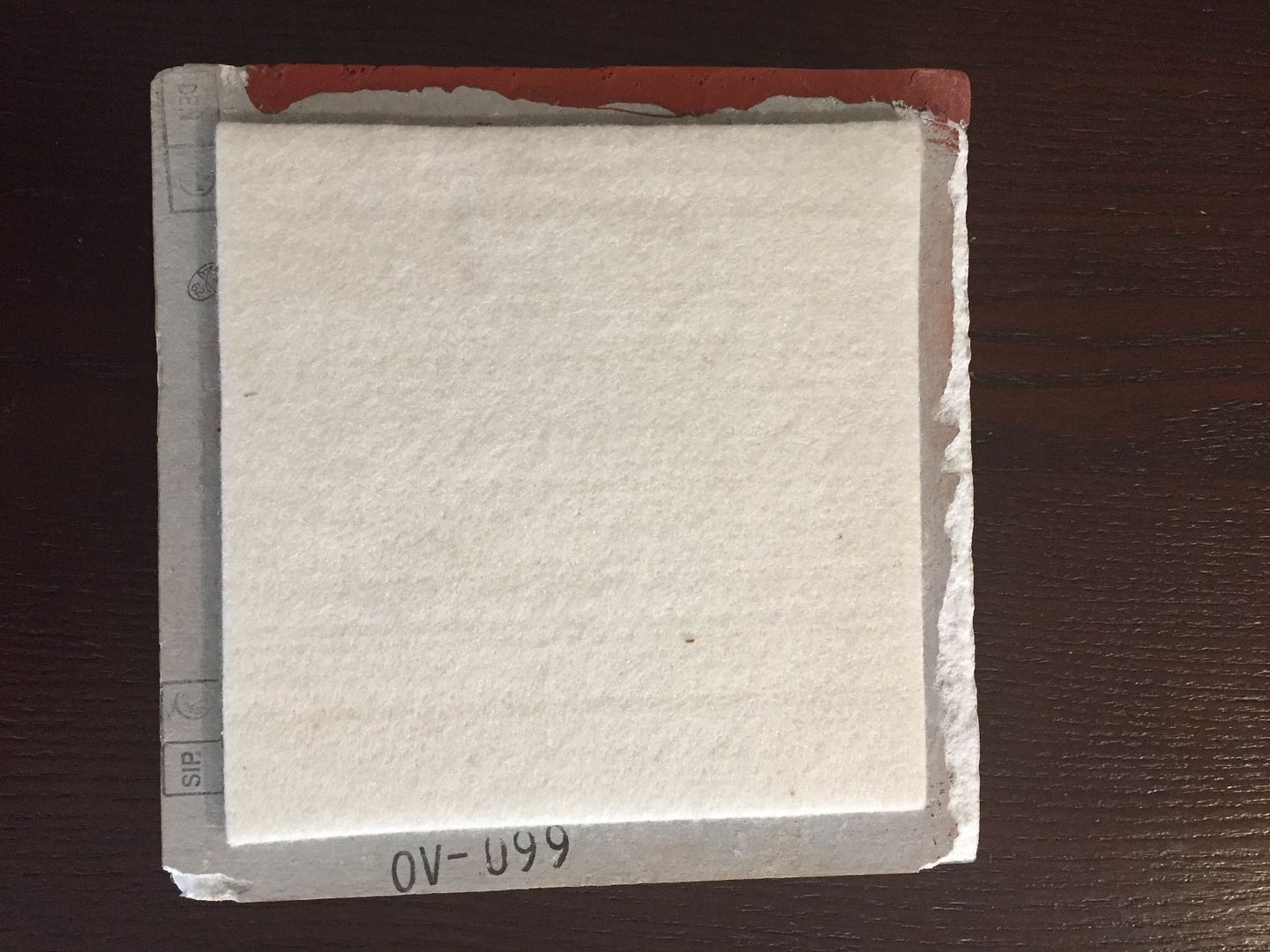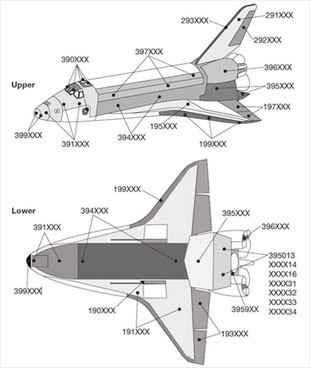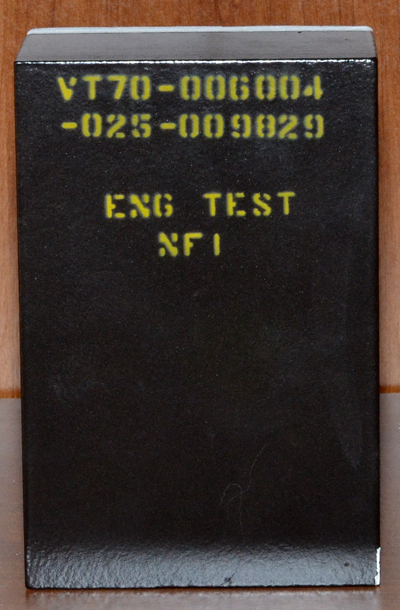|
Author
|
Topic: 'Engineering/Training-only' space shuttle tile
|
VetteC5RX
New Member Posts: 4
From: Deptford, NJ, United States
Registered: Apr 2016
|
 posted 05-02-2016 08:41 PM
posted 05-02-2016 08:41 PM
   
I was wondering if someone couldn't possibly help shed some light on the specifics of a part I have. This is a black HSRI tile that came from an estate sale. I've tried to do some research on what this may have been used for but it seems to be on the odd side. I do not believe this item to have flown but it's clearly been utilized to some degree. Here's what I assume thus far to be the case on this item: - It is not a fit/check tile
- Marked for "Engineering / Training", has inspection stamps, OV-099, and PVT (which I think stands for "Preflight Vehicle Testing").
- Has RTV and Nomex bonded to the tile
- Stamped OV-099 rather than STA-099
- Appears to have QA passed stamps?
My guess is that since this is made from final production material that perhaps this part was used during the conversion of STA-099 to OV-099 and was used to test step, gap, and OML contour criteria with an actual flight ready component? The Nomex looks to be in too good of a condition and the RTV is only along one side of the tile which tells me this wasn't fully bonded to the vehicle but must have been used in some process specific to OV-099, but to what extent I do not know. I've seen tiles out "in the market" both unflown and flown and I don't see many vehicle specific marking. I know all of the vehicles were built to identical standards (save for Columbia which was different) so tile location numbers were used. Due to lack of parts inventory during the early shuttle period I believe tile stocks were simply organized by location number printed on them; I do not believe tiles were specifically assigned to a vehicle in advance, is that correct? Has anyone else come across a tile with similar characteristics? I'd love to have some more information from the group as many of you likely have more insight than I do. Please see images below. Thanks! — Joe  
|
CMikeW
Member Posts: 89
From: United States
Registered: Apr 2013
|
 posted 05-03-2016 01:51 PM
posted 05-03-2016 01:51 PM
  
Your tile looks to be the twin of one I recently had. My thought is that it was a tile that was being processed for installation, but something caused it to be rejected so it became a show and tell item. It's possible you could use the serial number to find out its history. |
SpaceAholic
Member Posts: 4437
From: Sierra Vista, Arizona
Registered: Nov 1999
|
 posted 05-03-2016 01:55 PM
posted 05-03-2016 01:55 PM
   
Prima facie evidence that a tile bearing sealant doesn't independently substantiate a claim of flown provenance. |
CMikeW
Member Posts: 89
From: United States
Registered: Apr 2013
|
 posted 05-03-2016 03:17 PM
posted 05-03-2016 03:17 PM
  
Since the SIP (white nomex felt) doesn't have any RTV on it it was never prepped for bonding to an orbiter. |
VetteC5RX
New Member Posts: 4
From: Deptford, NJ, United States
Registered: Apr 2016
|
 posted 05-04-2016 12:47 AM
posted 05-04-2016 12:47 AM
   
No, I can tell this item was not flown; only that it was handled in some capacity. It wasn't fully bonded, however, my assumption is that whatever its purpose it was utilized in conjunction with a vehicle rather than just internal testing or display due to the "OV-099" stamp. That wouldn't be necessary unless this tile was utilized specifically for something to do with Challenger.I noticed earlier that the front surface of the tile has a number of what appear to be needle holes in them. Once I saw these something clicked and I began to do some more reading I found that post flight -51B Challenger was slated to fly mission -51C, however, was replaced by Discovery. It took a lot more digging but the reason for the switch was due to substantial TPS damage discovered after flight -51B where as much as full portions of the TPS had dislodged and fell off of the vehicle. NASA seemingly attributed this level of damage to a) the current waterproofing method for the TPS at the time and b) the continuous back to back heavy use of Challenger during that time period enabled the waterproofing agent to break down the RTV sealant bonding the TPS tiles to the vehicle. Because OV-099 was to spend an extended period in OPF Discovery was given flight -51C. In looking at the holes on this tile I wonder whether or not this unit was part of the testing done on Challenger post flight -51B that established the new waterproofing agent that was to be used on all vehicles going forward. It would explain the use of a "flight ready" tile, the OV-099 marking, the PVT and "engineering" labels, as well as the needle holes in the front surface. It's possible the amount of RTV that is seen on this tile could be from the various tests they subjected the tile to ensure the RTV was compatible with the new waterproofing? Obviously this didn't fly nor was it fully bonded to the vehicle; but assigned to it. The front face of the tile is also lighter in color as is the color of the tile location number; perhaps this was torched during waterproofing testing? The idea is a stretch but I can't think of much that would facilitate a PVT as well as OV-099 stamp; those wouldn't be necessary for a simple display or tinkering piece. |
Jim Behling
Member Posts: 1463
From: Cape Canaveral, FL
Registered: Mar 2010
|
 posted 05-04-2016 10:13 AM
posted 05-04-2016 10:13 AM
   
You're reading too much into the OV-099 stamp. The stamp is not in typical location for hardware that would be installed nor would there be any point to label a test tile for a specific orbiter if it is to be used for generic testing. Tiles were specific to a vehicle. This just may have been a scrapped tile and they are just labeling which orbiter it was originally for.
quote:
Originally posted by VetteC5RX:
Stamped OV-099 rather than STA-099
STA-099 never had any tiles. |
Robert Pearlman
Editor Posts: 42981
From: Houston, TX
Registered: Nov 1999
|
 posted 05-04-2016 10:35 AM
posted 05-04-2016 10:35 AM
   
quote:
Originally posted by VetteC5RX:
...and PVT (which I think stands for "Preflight Vehicle Testing").
I believe PVT stood for Pulse Velocity Test, which was performed on tiles already bonded to the orbiter. That said, whether the marking was applied prior to bonding to indicate which tiles were to be tested or after the test was completed, I don't know. |
garymilgrom
Member Posts: 1966
From: Atlanta, GA
Registered: Feb 2007
|
 posted 05-04-2016 10:44 AM
posted 05-04-2016 10:44 AM
   
The 394 prefix on the number indicates it was designed for the underside/belly area as shown in this legend from cS. There were likely a great deal of these made as the shuttle team got used to the tiles and trained on them. Here's a few more. I believe the white versions were placeholders for Columbia's delivery flight from California to KSC.  
And here's one with documentation from Densification Testing. The bottoms of the tiles were made denser to allow better bonding to the orbiter.  |
VetteC5RX
New Member Posts: 4
From: Deptford, NJ, United States
Registered: Apr 2016
|
 posted 05-04-2016 02:03 PM
posted 05-04-2016 02:03 PM
   
quote:
Originally posted by Jim Behling:
nor would there be any point to label a test tile for a specific orbiter if it is to be used for generic testing.
Jim, That's my point; there would be no reason to label a tile to a particular vehicle unless the testing or experimentation were specific to that vehicle. I've seen lots of tiles and know that they are not typically stamped for a vehicle when used. I've seen both scrap, and fully unused tiles and of the ones that I've seen come off of a vehicle they do not have any particular "OV" stamp. More than the stamp the needle holes in this tile lead me to think this may have had some role in testing of the post -51B TPS failure issue, which was experienced on Challenger.
quote:
Originally posted by Robert Pearlman:
I believe PVT stood for Pulse Velocity Test, which was performed on tiles already bonded to the orbiter.
Robert; This tile doesn't appear to have been bonded to the vehicle; the RTV that's on it might have been applied when it was mocked up to filler bars I'm thinking. I hadn't read about "Pulse Velocity Tests," I'll have to look that up; Thanks! |

















